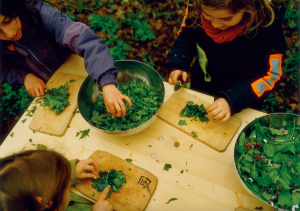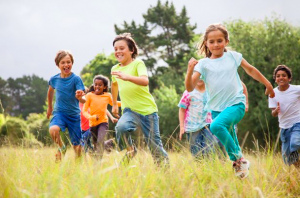Thoughts on Outside Time
The following reflection is from a guest blogger, Dan Johnson who teaches at the Bellwether School in Williston, VT. Through examining the microcosm of kids’ creative and imaginative play we see the quality of opportunities available in a holistic school…
I work at a small holistic education school where students expect a full hour of unstructured play each day in our large play yard. Through the few years I have worked here, it has become ever clearer that this is not only an important outlet for their spirit and body, but that it is also an extremely valuable time for me as an educator to learn from my students.
This past week there was an incident during the afterschool program which one student described as “war; everyone was crying.” There had been conflict over a space and some toys, and it had spiraled out until almost all the children were involved on one side or the other.
 Earlier in the year, several 4th and 5th grade girls had begun imaginative play around the idea of a restaurant. They gathered dishes, pans, and utensils, and created beautiful dishes of leaves, grass, and blossoms. Their play was highly developed, very organized, and seemed to be very satisfying. But as is often the case when people are deeply passionate about their work/play (these words, to Montessori, are quite interchangeable for children, and some adults), their activity attracted unwelcome attention. In this case there were younger children who wanted to join the play, and there were also peers who felt that the girls were “hogging all the stuff.”
Earlier in the year, several 4th and 5th grade girls had begun imaginative play around the idea of a restaurant. They gathered dishes, pans, and utensils, and created beautiful dishes of leaves, grass, and blossoms. Their play was highly developed, very organized, and seemed to be very satisfying. But as is often the case when people are deeply passionate about their work/play (these words, to Montessori, are quite interchangeable for children, and some adults), their activity attracted unwelcome attention. In this case there were younger children who wanted to join the play, and there were also peers who felt that the girls were “hogging all the stuff.”
Anyone who has spent time among children know already where this story goes. But it is worth thinking about this situation more closely.
The 4th/5th/6th grade class has been studying the world and its many nations, and trying to learn all we can about conflict and how best to get along. There have been many opportunities to reflect on the possibility of peace and the activities of a democracy. As we wove these ideas through our classroom, it occurred to me that the work these children do is much like the work we adults do, and that, if we are to work towards peace in the world at large, it is very much the case that we need start here. For if we cannot accomplish it within one classroom, or one school, it seems highly unlikely that we should ever do so in the world at large. Thoughts on that grim possibility another time.
For now, though, I am fascinated by the analogy of the children’s imaginative restaurant and the school itself. For the school is no less an imaginary structure than the restaurant, tax codes and bank accounts and parking spaces and meeting agendas notwithstanding, for these are all invented and crafted artifacts no less than the plate of blossoms the girls present to their patrons.
 This realization, or this analogy, gives me an opportunity to reflect on myself and on my students in a way that many schools or institutions could not permit. At our school, adult’s work and child’s work are mutually supportive. Yet the idea that adult work is more serious or important than children’s work is a core value in most contemporary life. And this value informs our educational policies and practices in extremely harmful ways. Furthermore, it degrades the adult work by disallowing it the possibility of freedom of action, imaginative arc, or collaborative plasticity. Instead we insist on external controls to tame our selves, lacking trust in possibility or play. And consequently, while we pretend (yes, pretend) to teach our children math, we are actually teaching them that none of us can be trusted, except insofar as we satisfy external controls: teachers, parents, bosses.
This realization, or this analogy, gives me an opportunity to reflect on myself and on my students in a way that many schools or institutions could not permit. At our school, adult’s work and child’s work are mutually supportive. Yet the idea that adult work is more serious or important than children’s work is a core value in most contemporary life. And this value informs our educational policies and practices in extremely harmful ways. Furthermore, it degrades the adult work by disallowing it the possibility of freedom of action, imaginative arc, or collaborative plasticity. Instead we insist on external controls to tame our selves, lacking trust in possibility or play. And consequently, while we pretend (yes, pretend) to teach our children math, we are actually teaching them that none of us can be trusted, except insofar as we satisfy external controls: teachers, parents, bosses.
 How do these ideas relate to our dispute over a space and some toys? We teachers could have made a rule. Instead, we brought the children together, and started a conversation about outside time. There were a few teacher comments, but mostly it was a conversation led by the children. After they had spoken, they called on a peer, who then did the same. That emphasized that the students were sharing responsibility for the communication, and that it was not a teacher-led discussion. Some students offered solutions, some pointed fingers. We encouraged students to share feelings rather than narratives, as narratives always become grounds for new conflict, but feelings create space for honesty and compassion. As the conversation went on, some children became impatient, and began to leave the circle. And the conversation slowly disintegrated, without any real clear resolution.
How do these ideas relate to our dispute over a space and some toys? We teachers could have made a rule. Instead, we brought the children together, and started a conversation about outside time. There were a few teacher comments, but mostly it was a conversation led by the children. After they had spoken, they called on a peer, who then did the same. That emphasized that the students were sharing responsibility for the communication, and that it was not a teacher-led discussion. Some students offered solutions, some pointed fingers. We encouraged students to share feelings rather than narratives, as narratives always become grounds for new conflict, but feelings create space for honesty and compassion. As the conversation went on, some children became impatient, and began to leave the circle. And the conversation slowly disintegrated, without any real clear resolution.
Some students were upset they had missed some time to play. Others resumed old disputes. There was no magic answer to the problems. It was not expected. There was no expectation that the case would be settled, a plaintiff confirmed or denied, a defendant sentenced or reprieved. Yet, later in the day, two students who had been bickering for a week suddenly found time and space to connect and play together. And there was clearly a shift in the atmosphere, though it did not fix any people, solve any problems, or do away with any conflict.
Outside time is, on the one hand, a chance for teachers to catch our breath, to catch up with each other and have adult conversations. On the other hand, watching the children in their self-directed activities is also an extremely valuable time to learn how the children interact independently. What strategies and tactics are they using to further their play? How do they gather together? To whom are they naturally attracted? Do they constantly have conflict with one or two people, yet consistently seek that person out? And how is conflict resolved?
For by studying these moments, we can discover much about ourselves, and can find deep possibilities to reflect on the world at large.

 Holistic Education Initiative
Holistic Education Initiative